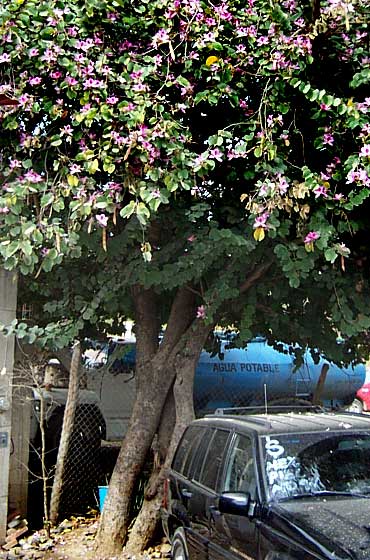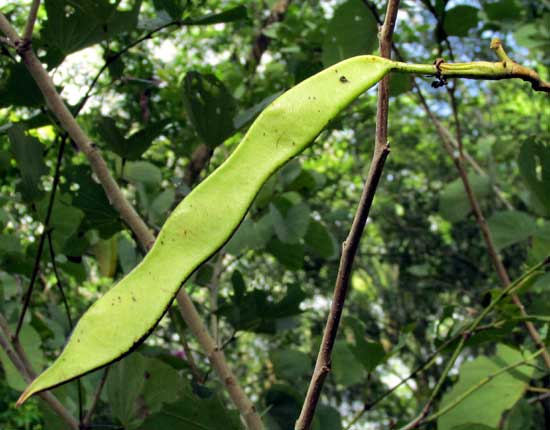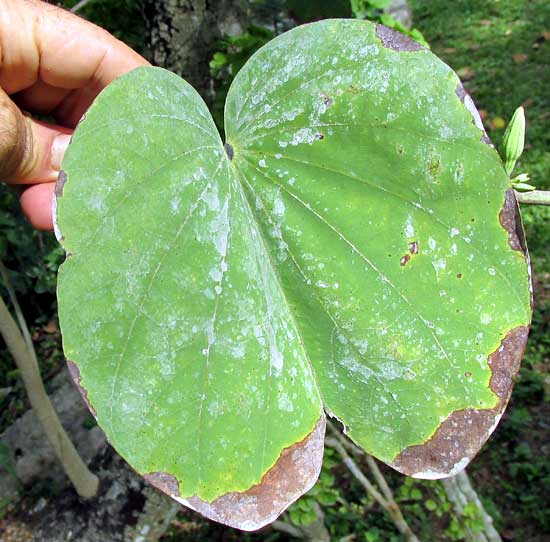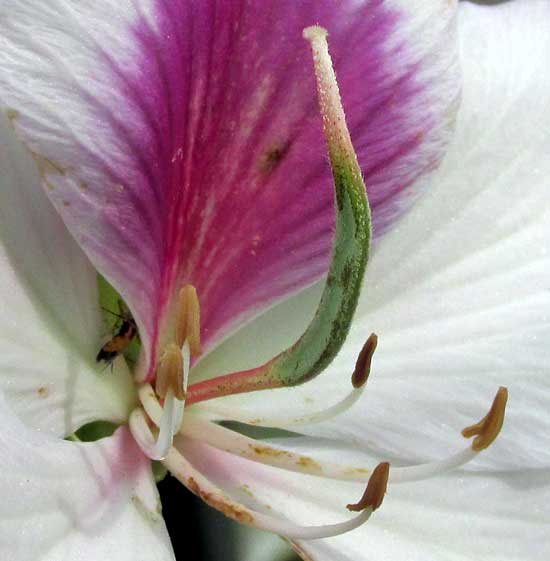Excerpt from Jim Conrad's
Naturalist Newsletter

from the January 12, 2007 Newsletter, Issued from Sierra Gorda Biosphere Reserve Headquarters in Jalpan, Querétaro, MÉXICO
PURPLE ORCHID TREE
Maybe the most spectacular flowering tree at this moment is a smallish Bean-Family member planted fairly regularly in people's yards and along roads. Below, you can see one in full bloom.

A close-up of its four-inch-wide, rose-colored flowers and one of its curious, cow-foot-shaped leaves is above.
This is the famous Purple Orchid Tree, BAUHINIA VARIEGATA, originally from India and China but now planted worldwide in the tropics. Wild members of the genus Bauhinia live here but they're not nearly as showy as this species. Like the Poinsianas I told you about last week, Purple Orchid Trees balance their gorgeous flowering periods with an ugly time, when they bear abundant, flat seedpods. Those seedpods snap open when they reach a certain state of dryness, scattering brown seeds everywhere.
I've always been partial to the genus Bauhinia because it's an easy Bean-Family member to identify. Especially in our scrub country there are so many Bean-Family members with feathery, compound leaves -- the Acacias, the Caesalpinias, the Mimosas, the Albizias, the Leucaneas, etc. -- that it's very hard to differentiate them, especially when they're not flowering, as is the case now. But, Bauhinias have those nice leaves with shallow clefts at their apexes, looking like a cow's hoof-print, almost yelling out the tree's identity.
from the June 19, 2016 Newsletter issued from Hacienda Chichen Resort beside Chichén Itzá Ruins; limestone bedrock; elevation ~39m (~128ft), N20.675°, W88.569°; central Yucatán state, MÉXICO
PURPLE ORCHID TREE WITH WHITE FLOWERS
This week another flowering orchid tree turned up, but its flowers were white with only a purple splotch and some purple along the petals' margins. With a thatch-roofed hut in the background -- not the one where I live -- this week's white-flowered orchid tree is shown below:

The tree bore maturing, legume-type fruits, so clearly it wasn't a form of the hybrid, which is sterile. You can see the white-flowered tree's eight-inch-long fruit (20cm) below:

So, was this white-flowered tree the other commonly planted orchid tree, Bauhinia purpurea?
Fortunately, there's a 2014 PDF document by José Manuel Sánchez de Lorenzo-Cáceres freely downloadable on the Internet, with excellent pictures and a good identification key that made our tree easy to identify. You can search for the document's name, "Notas sobre Bauhinia purpurea L., Bauhinia variegata L. y su híbrido Bauhinia x blakeana Dunn (Leguminosae-Caesalpinioideae)."
Two easily visible features separate Bauhinia purpurea from Bauhinia variegata. In Bauhinia purpurea, the cowhoof-shaped leaves are divided for 1/3-½ their length, while those of Bauhinia purpurea are divided only ¼-1/3 their length. Below, you can see a leaf from our hut tree:

Our tree's leaves were divided ¼-1/3 their length, so that's a vote for Bauhinia variegata.
The other main feature is that Bauhinia purpurea flowers produce only three fertile stamens, while Bauhinia variegata produces five. A close-up of our tree's stamens is shown below:

Along with the large, greenish pistil pointing upward, there are five stamens with white, curving filaments tipped with brown, arrowhead-shaped anthers, so that's another vote for Bauhinia variegata.
So, now we know that there's considerable difference in flower color in this much-planted tropical tree from southeastern Asia.